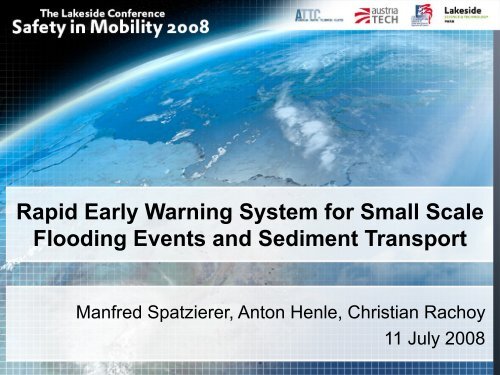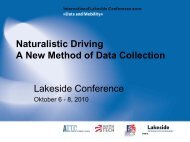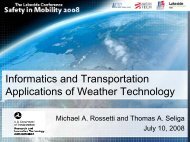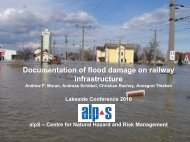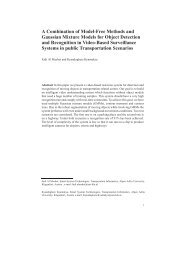Rapid Early Warning System for Small Scale Flooding Events and ...
Rapid Early Warning System for Small Scale Flooding Events and ...
Rapid Early Warning System for Small Scale Flooding Events and ...
Create successful ePaper yourself
Turn your PDF publications into a flip-book with our unique Google optimized e-Paper software.
<strong>Rapid</strong> <strong>Early</strong> <strong>Warning</strong> <strong>System</strong> <strong>for</strong> <strong>Small</strong> <strong>Scale</strong><br />
<strong>Flooding</strong> <strong>Events</strong> <strong>and</strong> Sediment Transport<br />
Manfred Spatzierer, Anton Henle, Christian Rachoy<br />
11 July 2008
Introduction<br />
> Flash flooding is a common phenomenon in the<br />
Alpine region during the summer. It is often caused<br />
by convective systems that hit a small catchment.<br />
> The rate of precipitation often exceeds 40-60 mm/h,<br />
the total amount of precipitation can in rare cases<br />
exceed 300-600 mm (e.g. Pitten catchment, Aug.<br />
2nd 1999)<br />
> Such extreme events are caused by slow moving<br />
thunderstorms over complex terrain.<br />
2
Introduction<br />
> Flash floodings are an immanent threat to live,<br />
goods <strong>and</strong> infrastructure in the Alpine region.<br />
Especially roads <strong>and</strong> railways may be severely<br />
damaged by thunderstorm-related flooding<br />
> The Austrian Federal Railways are in need of an<br />
early flash flooding warning system, to take<br />
measures to warrant security <strong>for</strong> passengers, staff<br />
<strong>and</strong> goods.<br />
3
Introduction<br />
Requirements of an early warning system<br />
> The time scale of reaction to excessive amounts of<br />
rainfall within a small catchment ranges from 15 to 60<br />
min.<br />
> An early warning system <strong>for</strong> flash flooding in Alpine<br />
areas has to be very close to a real time system.<br />
> Decisions that are based on the warnings have to be<br />
made within a couple of minutes.<br />
> It is also obvious that methods that involve excessive<br />
calculations <strong>and</strong> computer power are bound to fail.<br />
4
Study area<br />
Gumpenbach catchment<br />
5
Study Area<br />
Lowest radar beams<br />
from Zirbitzkogel<br />
<strong>and</strong> Feldkirchen<br />
radar stations.<br />
6
Method – 1 radar calibration<br />
> Weather radar data can be used to calculate the<br />
amount <strong>and</strong> rate of precipitation.<br />
> semi-empiric correlation between the reflectivity<br />
of particles in the atmosphere to microwave<br />
radiation <strong>and</strong> the rate of precipitation.<br />
> reflectivity of hydrometeors depends on their size<br />
<strong>and</strong> state<br />
> assumptions of these parameters have led to the Z-<br />
R relation:<br />
1.6<br />
Z = 200⋅R<br />
7
Method – 1 radar calibration<br />
> depending on vertical temperature profile <strong>and</strong> type of<br />
precipitation (strati<strong>for</strong>m or convective), errors up to<br />
50% are possible using this estimation.<br />
> Normally one has to calibrate the derived analysis of<br />
precipitation using rain gauge data (weather stations).<br />
> Calibration of radar in<strong>for</strong>mation may be carried out by<br />
means of a conditional merging technique: use of<br />
calibration field, which is computed through deviation between a<br />
radar gauge interpolation field <strong>and</strong> an interpolation field of radar<br />
pixel values at rain gauge sites. The deviation field is applied on<br />
the raw radar data, resulting in a precipitation field that<br />
preserves the spatial structure of the radar field while following<br />
the main field of the rain gauge in<strong>for</strong>mation.<br />
8
Method - 1 radar calibration<br />
Rain amounts (mm) between 19 June 20:00 <strong>and</strong> 20 June 02:00 (local time)<br />
9
Method - 2 synoptic situation<br />
10
Method - 2 synoptic situation<br />
Radar reflectivity representing the rate of precipitation<br />
at 5:00 pm on June 19th 2006<br />
11
Method - 2 synoptic situation<br />
Course of the thunderstorm over the Gumpenbach catchment<br />
12
Method - Definition of <strong>Warning</strong> Levels<br />
13
Summary <strong>and</strong> Outlook<br />
- overall good per<strong>for</strong>mance of fast responding model <strong>for</strong><br />
analysing flash flooding in a small catchment.<br />
- By using nowcasting methods to predict the movement<br />
<strong>and</strong> the development of a thunderstorm, we expect to<br />
retrieve fairly reliable precipitation <strong>for</strong>ecasts, which<br />
makes it possible to use the model in a predictive sense.<br />
Further work:<br />
- Investigation of more events in different catchments<br />
- Taking into account prediction of development <strong>and</strong><br />
movement of convective cells as well as obvious<br />
uncertainties of radar data<br />
14
Thank you <strong>for</strong> your attention.<br />
mspatzierer@meteomedia.at


